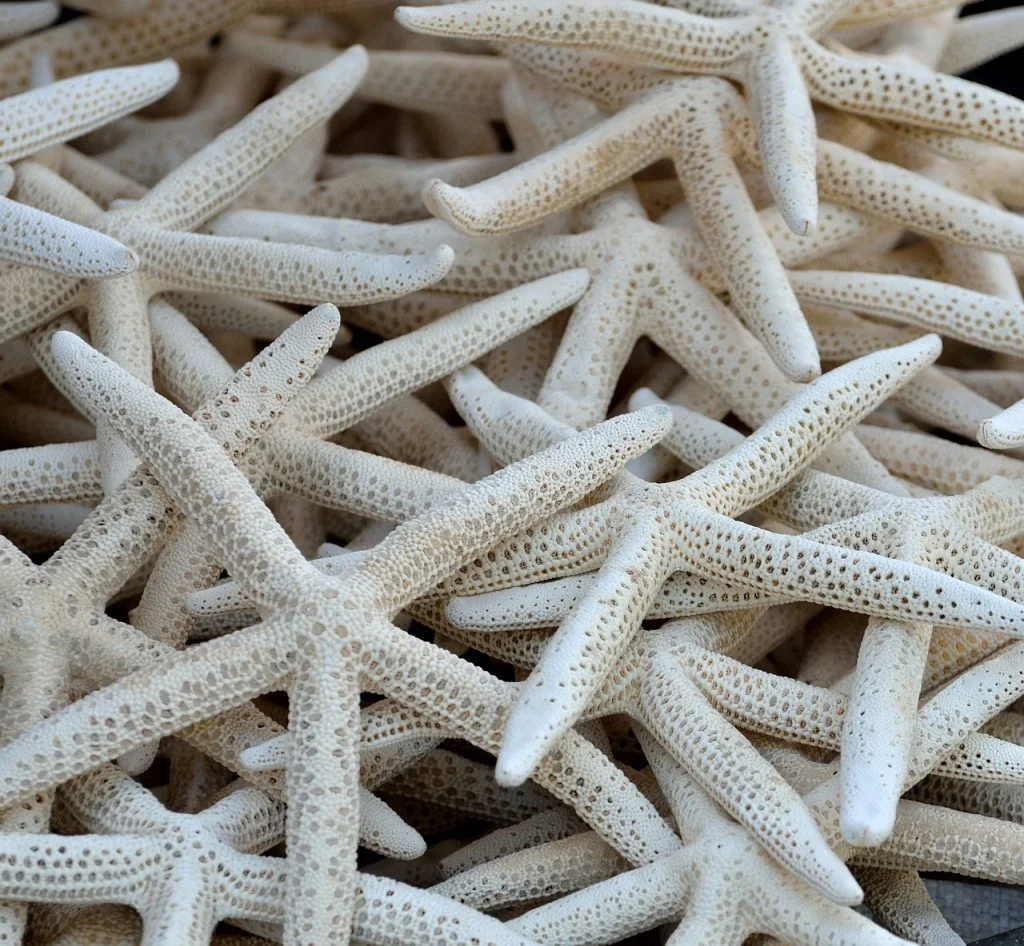Ever since I accidentally sat on a starfish during a beach vacation when I was six — a prickly surprise, I assure you — these fascinating creatures have captivated my imagination. Did you know that starfish can regrow lost arms? Imagine if I could regrow a new sense of dignity after that beach incident!
As a self-proclaimed starfish enthusiast, I’ve spent quite some time collecting information about them. Have you ever wondered if starfish have a favorite color? Spoiler: They don’t see colors like we do, but let’s dive into these 50 facts about starfish that are just as intriguing. Buckle up; it’s going to be a star-studded journey!
Every starfish has its own unique pattern, just like every human has their own unique story.
Unknown
Starfish Facts
Embark on an exciting journey with cool starfish facts! Read carefully, as every fact is a step closer to acing the quiz I created for you at the end of this page. Make me proud.
- Starfish, also known as sea stars, are echinoderms, a group that also includes sea urchins and sand dollars.
- There are over 2,000 species of starfish found in all the world’s oceans.
- Starfish typically have a central disc and five arms, though some species can have up to 50 arms.
- They are famous for their ability to regenerate limbs, and in some cases, entire bodies from a single arm.
- Starfish do not have blood; their vascular system is filled with seawater instead.
- Their mouth is located on the underside of their body, at the center of the disc.
- Starfish move using hundreds of tiny tube feet located on the undersides of their arms.
- These creatures can consume prey outside their bodies by extending their stomachs.
- Starfish have a unique ability to expel their stomach out of their body and envelop their prey.
- The lifespan of a starfish varies greatly between species; some live as long as 35 years.
- Starfish are not fish, as they do not have gills, scales, or fins.
- They sense their environment using a complex nervous system but do not have a centralized brain.
- Most species of starfish are predators, feeding mainly on mollusks such as clams and oysters.

- Starfish can change gender during their lifetime.
- Some starfish species can reproduce asexually through fragmentation.
- Starfish come in various colors, including red, blue, orange, gray, and brown.
- They play a significant role in the ocean’s ecosystem, often considered keystone species.
- The top surface of a starfish is covered with a hard, bony, calcified structure for protection.
- Starfish have a specialized water vascular system used for locomotion and feeding.
- Their tube feet are equipped with suction cups at the end, aiding in movement and capturing prey.
- Some starfish species exhibit bioluminescence, emitting light in dark environments.
- Starfish cannot survive in fresh water.
- When threatened, some starfish species can drop an arm to escape predators, later regenerating it.
- The temperature and salinity of their environment significantly affect their survival and reproduction.
- Starfish are preyed upon by sharks, manta rays, certain species of fish, and even other starfish.
- They can be found from the intertidal zone down to the abyssal depths of over 6,000 meters.
- Starfish do not swim, and they usually move quite slowly along the seabed.
- Their stomachs can digest food outside their bodies, allowing them to consume larger prey.

- Some species of starfish can endure extreme temperatures and high levels of salinity.
- Starfish play a crucial role in marine research due to their regenerative abilities and developmental biology.
- Environmental changes, such as ocean acidification and rising temperatures, impact starfish populations.
- Starfish are often used as a symbol in literature and folklore, representing regeneration and renewal.
- Some species of starfish exhibit commensal relationships with other marine organisms.
- Starfish larvae are free-swimming and undergo several stages before settling down and transforming into the adult form.
- Due to their unique feeding habits, starfish can have a significant impact on the marine food chain.
- They have a simple eye spot at the end of each arm, allowing them to sense light and darkness.
- Starfish are vulnerable to several diseases, including sea star wasting disease, which has decimated populations.
- They can consume prey much larger than their mouths by digesting them externally.
- Starfish are popular in the aquarium trade but require specific care to thrive in captivity.

- Their ability to regenerate lost parts has made them a subject of study in regenerative medicine.
- Despite their name, starfish are more closely related to sea urchins than to fish.
- Starfish populations are indicators of the health of marine ecosystems.
- Overharvesting and habitat destruction pose significant threats to certain starfish species.
- Some cultures consider starfish a delicacy, while others use them for medicinal purposes.
- Starfish can vary significantly in size, from less than an inch to over a foot in diameter.
- Their feeding habits can help control the population of marine invertebrates in their habitat.
- Starfish are often affected by pollution, particularly oil spills and plastic waste in the oceans.
- Conservation efforts are in place in various regions to protect vulnerable starfish species.
- They have a unique skeletal composition, consisting of ossicles embedded in a web of fibrous proteins.
- Starfish exhibit a variety of reproductive strategies, including broadcasting, spawning, and brooding.
Starfish Myths

I hope you liked all these fun facts about sea stars, because now it’s time to unravel the mysteries and discover what’s true and what’s a myth. How many arms do starfish have? Are you sure you know the answer?
- Starfish Have Five Arms
While many starfish have five arms, there are species with 10, 20, or even 40 arms. The number of arms can vary widely among the different species of starfish. - Starfish Can’t Regenerate Lost Arms
Starfish are famous for their ability to regenerate lost arms. In fact, some species can regrow an entire body from just a portion of a severed limb. - Starfish Are Always Star-Shaped
Although the classic star shape is common, some starfish species have irregular shapes. This diversity in form reflects their different habitats and lifestyles. - Starfish Are Fish
Despite their name, starfish (or sea stars) are not fish. They are echinoderms, more closely related to sea urchins and sand dollars. - Starfish Don’t Move
Starfish can move, though slowly. They use hundreds of tiny tube feet on their undersides to crawl along the ocean floor. Some can even ‘walk’ using their arms.
No products found.
Starfish Quotes

While finding quotes was quite easy, I had a hard time finding the person behind each quote. If you know, please let me know in the comments. Here are my five favorite ones:
The starfish is a reminder that everything is connected, the tide, the stars, and us.
Unknown
Reflecting on the interconnectedness of nature, using the starfish as a symbol to link the ocean, the cosmos, and humanity.
Like a starfish, the heart endures its amputation.
Unknown
This one metaphorically compares the heart’s ability to recover from emotional pain to a starfish’s ability to regrow lost limbs.
A starfish’s beauty is in its resilience and ability to create a ripple effect in the vast ocean.
Unknown
This quote highlights the starfish’s resilience and its impact on the environment, symbolizing the idea of small actions leading to larger effects.
In the ocean of life, be like a starfish – flexible, resilient, and always regenerating.
Unknown
It uses the starfish as an analogy for adaptability and continuous growth in life.
The starfish teaches us not to underestimate the small things in the grand tapestry of life.
Unknown
This quote is a reminder of the importance and influence of small creatures and elements in the larger scheme of life.
Starfish FAQ

Having journeyed through a sea of starfish quotes, we now anchor at the FAQ harbor. Keep your eyes peeled and your mind sharp – there’s a quiz on the horizon that will test your starfish knowledge.
- Do Starfish Have Eyes?
Absolutely! Starfish do have eyes, but they’re not like the eyes we’re used to. Each of their arms has a tiny eye at the tip. These eyes are pretty simple and can’t see in detail like ours, but they help the starfish sense light and dark, which is handy for navigating their underwater world. - What Are the Types of Starfish?
Oh, the variety is amazing! There are about 2,000 species of starfish, and they come in all sorts of shapes, sizes, and colors. Some of the well-known types include the Common Starfish, the Crown-of-Thorns Starfish, and the Sunflower Starfish. Each has its own unique habitat and characteristics. - What Is the Scientific Name of Starfish?
Starfish belong to a group called ‘Asteroidea‘. This name comes from ‘Aster‘, which means ‘star’ in Greek, and ‘oidea’, which sort of means ‘like’, so together it’s like saying ‘star-like’. It’s a fitting name for these star-shaped sea creatures, isn’t it? - Is a Starfish an Animal?
Indeed, starfish are animals! They might not look like your typical furry pet, but they’re part of the animal kingdom. Specifically, they fall under the echinoderm group, which also includes sea urchins and sand dollars. These creatures are known for their unique radial symmetry and spiny skin. - How Many Eyes Does a Starfish Have?
This one’s interesting. Since starfish typically have five arms, they usually have five eyes as well, one at the tip of each arm. But remember, these eyes are quite different from human eyes. They’re more about sensing light than seeing detailed images.
No products found.
Starfish Trivia

Get ready for a splash of fun with our starfish quiz! Miss a question, and you might just turn into a starfish’s long-lost cousin for a day!
Conclusion
Let’s face it, starfish might just be the ocean’s best-kept secret. Who knew that these five-armed celebrities could regenerate lost limbs or have stomachs that dine out? It’s like having a superpower, but underwater.
So next time you’re enjoying a beach day, remember that there’s a whole world of starry drama beneath the waves. Quick question: if you could be any sea creature for a day, would you choose the all-star starfish? If not, then what? Let me know in the comments.
4 Sources Used For This ArticleInteresting Facts About Starfishes – New Interesting Facts
A Complete Guide to Sea Star or Saltwater Starfish for Beginners – Vocal Media
Starfish – No Brain, No Blood… Yet Living Their Best Life!!! – World Animal Foundation


